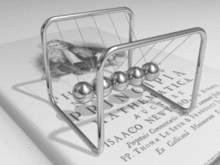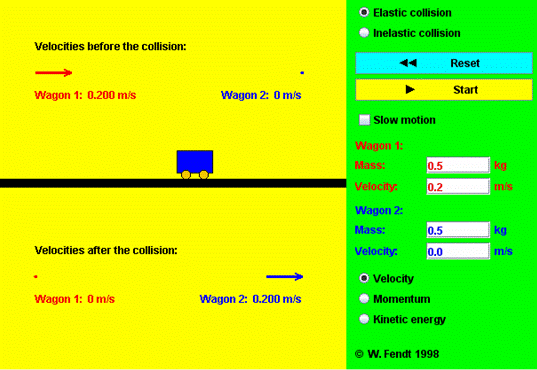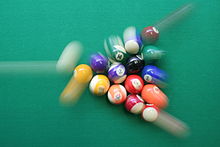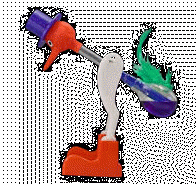|
Momentum - Part II
Objectives
| • Know that momentum is conserved in a closed system. • Be able to apply the law of conservation of momentum
to determine the outcome of collision or explosion events.
|
 |
Task 1 - Starter
Calculate:
|
a) The momentum of a 50kg student running at 4 m/s.
b) The momentum of a 2500g radio controlled car travelling at 6m/s.
c) The change of
momentum of a 1500kg car accelerating from 10 m/s to 25 m/s.
|
Task 2
Momentum is a useful quantity to help us predict the
outcome of collision or explosion events. In a closed system,
momentum can be transferred between objects, but the total
momentum is always conserved - even if energy is lost to the
surroundings. This is known as "the
law of conservation of momentum".
This can be expressed simply as:
|
"total momentum before =
total momentum after" |
Your teacher will show you a few examples of momentum
being transferred in collisions, either with demonstrations or using the
simulation below.

(click on the image, or
this link to open the simulation in a new window.)
Task 3
The Law of Conservation of momentum is used in
conjunction with the momentum formula from last lesson:
|
p =
m × v
|
p =
momentum, measured in Newton-seconds (N
s or kg m/s
or kg ms-1).
m= mass, measured
in kilograms (kg).
v = velocity,
measured in metres per second (m/s
or ms-1). |
| We are going to try applying the law of
conservation of momentum to find the outcome of several
collision events. Your teacher will explain how to solve
the example problem below: |
 |
|
Example 1
A red billiard ball of mass 0.15kg is
initially at rest, and is struck by the cue ball, which is
moving at a velocity of 8m/s to the right and has a mass of
0.17kg. The cue ball continues with a velocity of
0.5m/s to the right. What velocity does the red ball
move away?
You will need to:
• Draw diagrams showing the 'before' and 'after' scenarios.
• Calculate the momentum of each object before the
collision.
• Calculate the total momentum before the collision.
• Calculate the momentum of the cue ball after the
collision.
• Find the momentum transferred to the red ball.
• Find the velocity of the cue ball using p = m x v.
|
|
Example 2
An __________ of mass ___________ is
moving... etc!
You teacher will help
you to draw diagrams showing the
'before' and 'after'
scenarios and to label all known and unknown quantities.
You will need to:
• Calculate the momentum of each object before the
collision.
• Calculate the total momentum before the collision.
• Calculate the momentum of the ________ after the
collision.
• Find the momentum transferred to the _________.
• Find the _________ of the ________ using p = m x v.
|
Task 4
Apply the law of conservation of momentum to solve
these problems. You will need to draw clearly labelled
'before' and 'after' diagrams for each question to help you solve the
problem. Show full working for all your calculations.
|
Extension /
MAT work:
Consider the case
of object, of mass "m"
in motion at an initial velocity "vo"
striking an object of equal mass, which is
initially at rest. Show that, in a completely
inelastic collision where the two objects stick together,
they will move away with half the initial velocity of the
first object.
|
Homework
Complete
these momentum problems. Draw 'before' and 'after' diagrams
for each problem, and show full working for your calculations.
|

